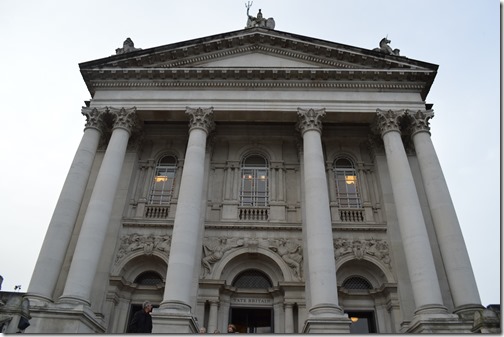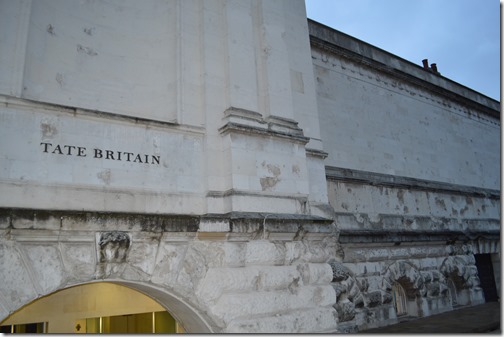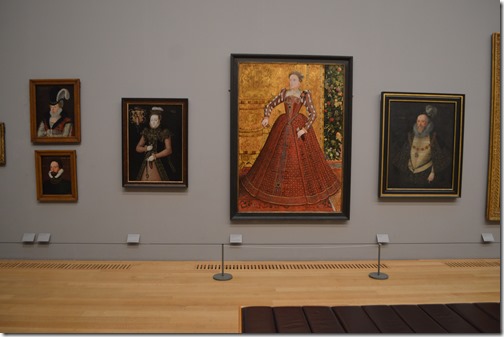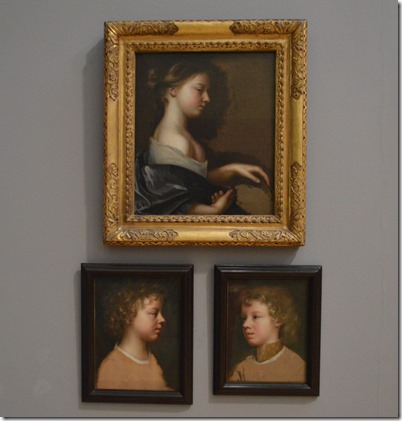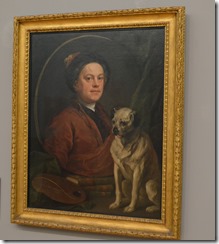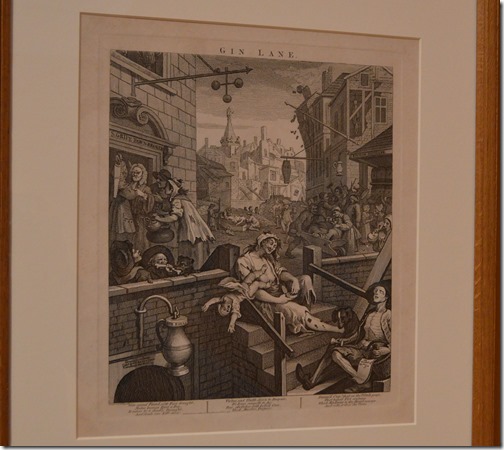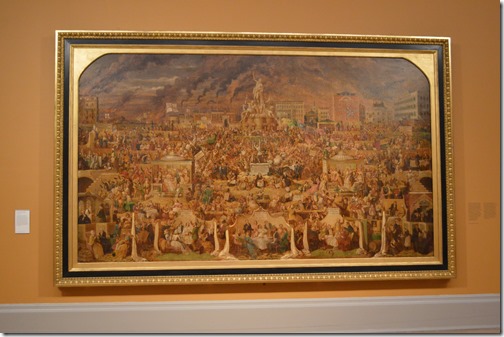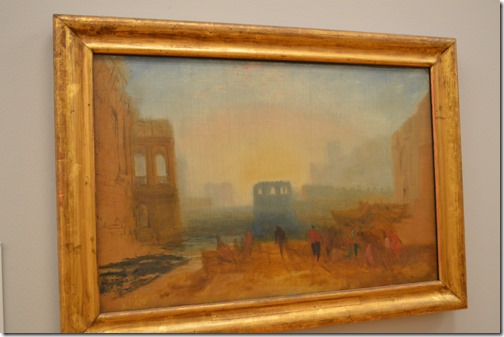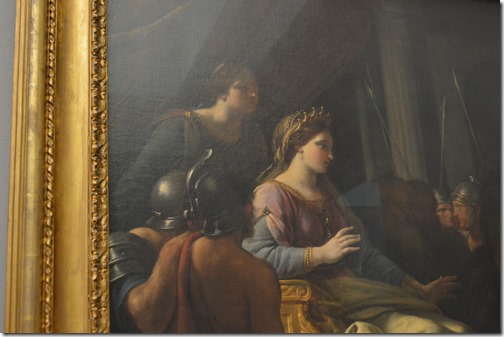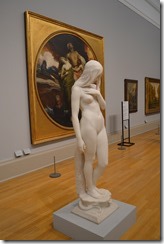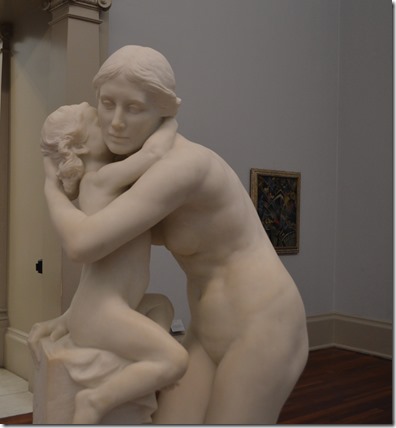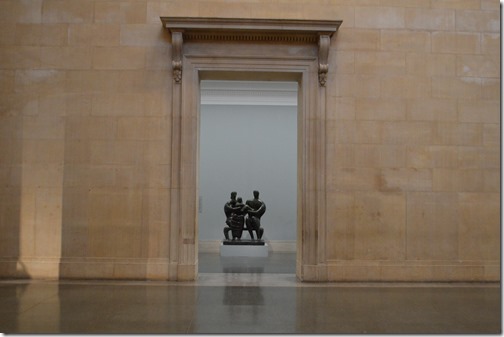Tate Britain is the first museum we visited on our trip to London last month. Like most museums in London, Tate Britain admission is free. There are a lot of free museums in London. Special exhibits within these museums are high priced, but most of the museum collections are free to walk around and gaze away your days and even some evenings in London.
Tate Britain is one of my favorite museums with its Millbank Road setting on a noisy traffic street beside the River Thames. There were not too many people crowding the galleries on a Tuesday afternoon in late November.
Tate Britain – The National Collection of British Art
I have no formal art education. I am more familiar with artists’ lives and building histories than I am with various art styles.
Tate Britain was called National Gallery of British Art when it opened as a museum in 1897, in the 60th year and near the end of Queen Victoria’s reign. This area of London along the River Thames between the Palace of Westminster and Vauxhall Bridge is called Millbank. The National Gallery of British Art was built on the former site of Millbank Prison. The former Millbank Prison (1816-1890) is an interesting story. The damp marshy River Thames prison site fostered disease in the place where prisoners scheduled for transport out of the UK waited months for their transport ship passage to a colony, like Australia.
Demolition of Millbank Prison began in 1902, while groundbreaking occurred in 1903 for the National Gallery of British Art building site.
Who was British Tate?
Sir Henry Tate, 1st Baronet (1819-1899) was born a common man who made his fortune in refined sugar. He became wealthy enough to support many charitable causes. Henry Tate donated 65 paintings to the British Government in 1889, along with £80,000 for the construction of an art gallery. Eventually, Henry Tate ultimately contributed about £150,000 for the Millbank site construction of the National Gallery of British Art when it opened July 21, 1897.
Henry Tate was given the peerage title 1st Baronet in 1898 by Queen Victoria for his generous gifts to the nation.
The side of the Tate Britain shows the scars of war with pock marks all around from WWII bomb damage.
Art Inside the Tate
Art is arranged chronologically in rooms inside the Tate Britain, with the earliest pieces from the 1500s.
Portrait of Queen Elizabeth I in large painting.
These three paintings were interesting to me due to the artist being a woman, Mary Beale (1633-1699). She became an important portrait painter in London and is described as Britain’s first professional female painter. The lower two portraits are her son Bartholomew Beale, painted in 1660 when Mary was in her twenties. Portrait of a Young Girl (1681) shows Mary Beale’s work as a mature painter.
William Hogarth (1697-1764) – social painter
Hogarth was a London born painter, engraver, illustrator who pioneered sequential art, whereby a series of pictures convey a story and information. Hogarth’s art provided commentary on social life in the Britain of his time.
William Hogarth self-portrait Painter and His Pug (1745)
One of the free special exhibits inside the Tate Britain was a room arranged for art pieces around the subject of alcohol.
Gin Lane (1751) – William Hogarth
This illustration is one of two in a series depicting Beer Street and Gin Lane. The original purpose of the illustrations was an image of Beer Street, a place where lives are happy and prosperous when drinking native English ale, in contrast to the downtrodden misery and poverty of drinking gin.
I wish Hogarth’s Beer Street had been displayed in the room too.
The painting in the Alcohol room that truly captivated me is a large painting, The Worship of Bacchus by George Cruikshank (1792-1878). He was nicknamed the ‘modern Hogarth’ in his time. He illustrated some of Charles Dickens’ early work, including Oliver Twist. Cruikshank became a leader in the British Temperance Movement to ban alcohol. The plaque for the painting states his father died in 1811 during a drinking competition.
The Worship of Bacchus (1860-62) – George Cruikshank
Cruikshank created this work to be used as a tool by the temperance movement. There are many scenes showing proper occasions for drink and the ravages of drink on society.
I have not the vanity to call it a picture, it being merely the mapping out of certain ideas for an especial purpose, and I painted it with a view that a lecturer might use it as so many diagrams…in the centre… is a madman. It may, indeed, be said that madness prevails over the whole set of this mass of worshippers, for excitement from strong drink and drunkenness is, in fact, temporary insanity.
In the crowd may be seen various acts of violence, cruelty, and brutality, at least as far as propriety would allow me to show them – for no artist, nor author, dare attempt to represent or describe, to the fullest extent, the horrible crimes and disgusting deeds that are committed under the influence of wine, beer, or spirits. No, it cannot, it dare not be done.
George Cruikshank on his painting The Worship of Bacchus
Close-up images from this painting can be seen on this Princeton University webpage.
JMW Turner (1775-1851)
Joseph Mallord William Turner’s talent was recognized early in his life. He was admitted to the Royal Academy at 14 and his first oil painting was exhibited at the Royal Academy in 1796. There are many Turner paintings in the Tate Britain and free guided tours of his work are offered by the museum.
He is commonly known as ‘the painter of light’. The plaques accompanying his work depict him as a highly competitive painter in his time.
Study for ‘Dido directing the Equipment of the Fleet’ (1826-1827).
Dido directing the Equipment of the Fleet was the centerpiece of Turner’s 1828 Royal Academy exhibition. Apparently, the finished painting is now a wreck.
Dido and Aeneas are from Virgil’s Aeneid and the story of the love between Dido, Queen of Carthage and Aeneas, a Trojan.
The Meeting of Dido and Aeneas (1766) – Nathaniel Dance-Holland (1735-1811)
Until this walk through the Tate, Dido was, for me, just a British singer with a lovely voice. I fell in love with Dido the queen when I looked upon Dance-Holland’s painting.
Sculpture at the Tate Britain
Eve (1900) – Robert Brock
The Kiss (1916) – Hamo Thornycroft (1850-1925)
The Tate has a large collection of Henry Moore. In 1938, JB Manson, director of the Tate Gallery declared, “over my dead body will Henry Moore ever enter the Tate”. Today there are over 600 pieces by Henry Moore in the Tate collection.
Family Group (1949) – Henry Moore (1898-1986)
One of the exhibits that intrigued me during our time in the Tate was the sound emanating through the central halls. I could not figure out what I was hearing.
Susan Philipsz: War Damaged Musical Instruments Tate Britain: Exhibition 21 November 2015 – 3 April 2016. War Damaged Musical Instruments features fourteen recordings of British and German brass and wind instruments damaged in conflicts over the last 200 years. The link is my YouTube video with about ten seconds of sound and bad camera work as I do a 360 in the Tate Britain hallways.
These are just a small sample of sights and sounds in Tate Britain. There are many ways to fill your days in London. Getting educated and cultured with free museum art is one of my favorite ways to spend my days in London.
During two other trips to London this past year we have been to the British Museum, Victoria and Albert Museum, Museum of Natural History, National Portrait Gallery, Wallace Collection and Museum of London. We walked by several other free museums without entering due to our tired feet. Museum viewing is tough on the feet standing around observing stuff for hours on end.
Loyalty Traveler – Hyde Park hike to Treasures of Natural History Museum London


